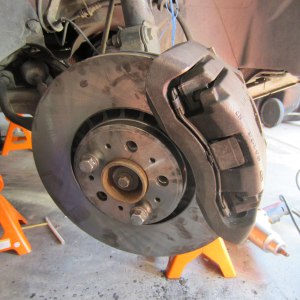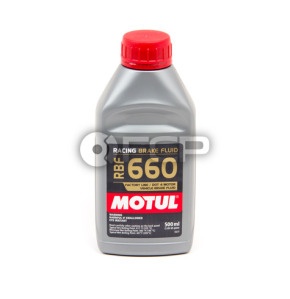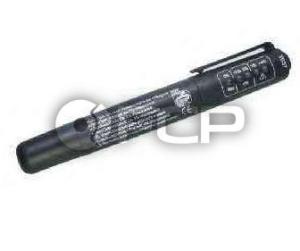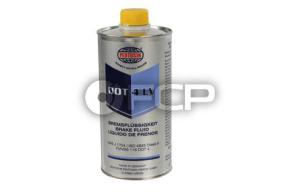 Brake fluid is a hydraulic fluid designed to be used in hydraulic brakes. Most brake fluid types are miscible and will absorb water, so it should be flushed to make sure the brake system has as little water in it as possible. When brake fluid is contaminated with moisture, it will lower the boiling point. This can cause a dangerous condition if the brake fluid boils under heavy braking - the resulting bubbles will significantly decrease the ability of the hydraulic system to apply the brakes. There are several types of brake fluids on the market. Only some can be used interchangeably, so it is important to know the different types and understand the differences:
Brake fluid is a hydraulic fluid designed to be used in hydraulic brakes. Most brake fluid types are miscible and will absorb water, so it should be flushed to make sure the brake system has as little water in it as possible. When brake fluid is contaminated with moisture, it will lower the boiling point. This can cause a dangerous condition if the brake fluid boils under heavy braking - the resulting bubbles will significantly decrease the ability of the hydraulic system to apply the brakes. There are several types of brake fluids on the market. Only some can be used interchangeably, so it is important to know the different types and understand the differences:
DOT 3:
Most passenger cars on the road manufactured before 2006 will be using DOT 3 brake fluid. This is the minimum allowable specifications to be road-legal in the United States. DOT 3 brake fluid can be mixed with DOT 4 and DOT 5.1 but will modify the ratings of the brake system to that of the lowest rated fluid. Minimum WET/DRY boiling points in degrees Fahrenheit: 281F/401F
DOT 4:
Most passenger cars built after 2004, sports cars, and heavy-duty cars typically use DOT 4 brake fluid. DOT 4 brake fluid can be mixed with DOT 3 and DOT 5.1 but will modify the ratings of the brake system to that of the lowest rated fluid. Minimum WET/DRY boiling points in degrees Fahrenheit: 311F/446F
DOT 5:
DOT 5 brake fluid is silicone-based requires a different brake system to prevent damage to seals and gaskets designed for a DOT 3 / DOT 4 / DOT 5.1 system. DOT 5 brake fluid CANNOT be mixed with DOT 3 / 4 / 5.1 brake fluid and is INCOMPATIBLE with seals and gaskets designed for DOT 3 / 4 / 5.1 brake fluid. Minimum WET/DRY boiling points in degrees Fahrenheit: 356F/500F
DOT 5.1:
This is the DOT 3 and DOT 4 compatible version of DOT 5 brake fluid. DOT 5.1 brake fluid can be mixed with DOT 3 and DOT 4 but will modify the ratings of the brake system to that of the lowest rated fluid. Minimum WET/DRY boiling points in degrees Fahrenheit: 356F/500F
Like many other fluids that are available for your car, there are multiple grades with different performance levels to meet many cost and performance requirements for consumers. For many passenger cars, a DOT 3 fluid that is bled and flushed once a year is perfectly adequate for a street driven vehicle.
However, for automotive enthusiasts or for high-performance cars, fluids that only meet the minimum wet/dry boiling points are not sufficient. Overheating and boiling the brake fluid will significantly deteriorate braking feel and performance. Continued driving with boiling brake fluid can lead to a complete loss of the braking system.
Several factors can change the boiling point of brake fluid, but the most important and controllable two factors are:
- Brake fluid quality
- Cleanliness of brake fluid
Brake fluid quality is easy. As a responsible driver of your vehicle, you can pick a brake fluid that meets the demands of your vehicle and how you drive it. Brake fluids will have a labeled wet and dry boiling point. Generally speaking, a higher wet/dry boiling point fluid will demand a higher price. Much like other specialty automotive fluids, once you reach a point in wet/dry boiling point you will need to start shopping online or at specialty automotive performance stores to find the products that meet higher requirements for enthusiasts and high-performance cars.
Cleanliness of the brake fluid comes into play after you've selected an appropriate high-quality brake fluid for your car. As soon as the bottle of brake fluid is opened and the seal is taken off, it will begin to absorb moisture from the air. Even that cap on the brake fluid reservoir will not completely prevent moisture from entering the system, as rubber brake lines, connections, and fittings will slowly diffuse moisture into the brake fluid. To maintain peak performance and maximum boiling temperature of the brake fluid, it is important to exchange and flush out brake fluid on a regular basis. The interval at which this needs to be done depends on the vehicle and driving style. Generally speaking, flushing out brake fluid once a year will be sufficient enough to rid the system of air bubbles and exchange the old fluid for fresh fluid.
It is also possible to test brake fluid with a brake fluid tester pen. The tester pen will give a rough estimate of moisture content in the brake fluid which can be used as an accurate indication of when to flush the brake fluid. You can also use copper testing strips to test for copper content in the brake fluid. When brake fluid absorbs moisture and the anti-corrosion additives wear off, one of the first components to corrode are copper fittings. Testing for copper content is also an accurate way to determine when to change the brake fluid.
At this point, you might be thinking: "I'll just find the most affordable brake fluid with the highest boiling point, flush it on a regular schedule, and I'll be good to go!" - well, kind of. There's one last factor to consider.
As a general rule of thumb, the viscosity of brake fluid will increase as the wet/dry boiling point increases. Race cars that use high boiling point fluid (and subsequently high viscosity fluid) are driven in carefully controlled conditions. Street-driven vehicles that are running viscous fluid may encounter issues with stiff pedal and poor braking performance in cold weather. Vehicles equipped with anti-lock brakes (ABS) may also have a decrease in ABS performance with viscous brake fluid. Modern vehicles with brake-assisted driveline aids (such as traction control or stability control) may also have problems with thicker brake fluid. As an example, modern Volvo vehicles such as my Volvo XC90 V8 equipped with Dynamic Stability and Traction Control (DSTC) require low-viscosity brake fluid that allows the driveline aids such as ABS and DSTC to function properly. Read your owner's manual to determine if your vehicle requires low-viscosity brake fluid to ensure that these driver aids perform their function when required.
How have your experiences with brake system maintenance been?
About the Author: Andrew Peng
 Andrew is an aerospace engineer and car fanatic that enjoys working on his garage of Volvos and Subarus. When he's not busy attending car meets and shows or taking things apart, he enjoys driving his cars and finding interesting new ways to break them. He can be reached via his personal website at http://andrewpeng.net, Facebook, Google+, Instagram, or Twitter.target="_blank">Twitter.
Andrew is an aerospace engineer and car fanatic that enjoys working on his garage of Volvos and Subarus. When he's not busy attending car meets and shows or taking things apart, he enjoys driving his cars and finding interesting new ways to break them. He can be reached via his personal website at http://andrewpeng.net, Facebook, Google+, Instagram, or Twitter.target="_blank">Twitter.














